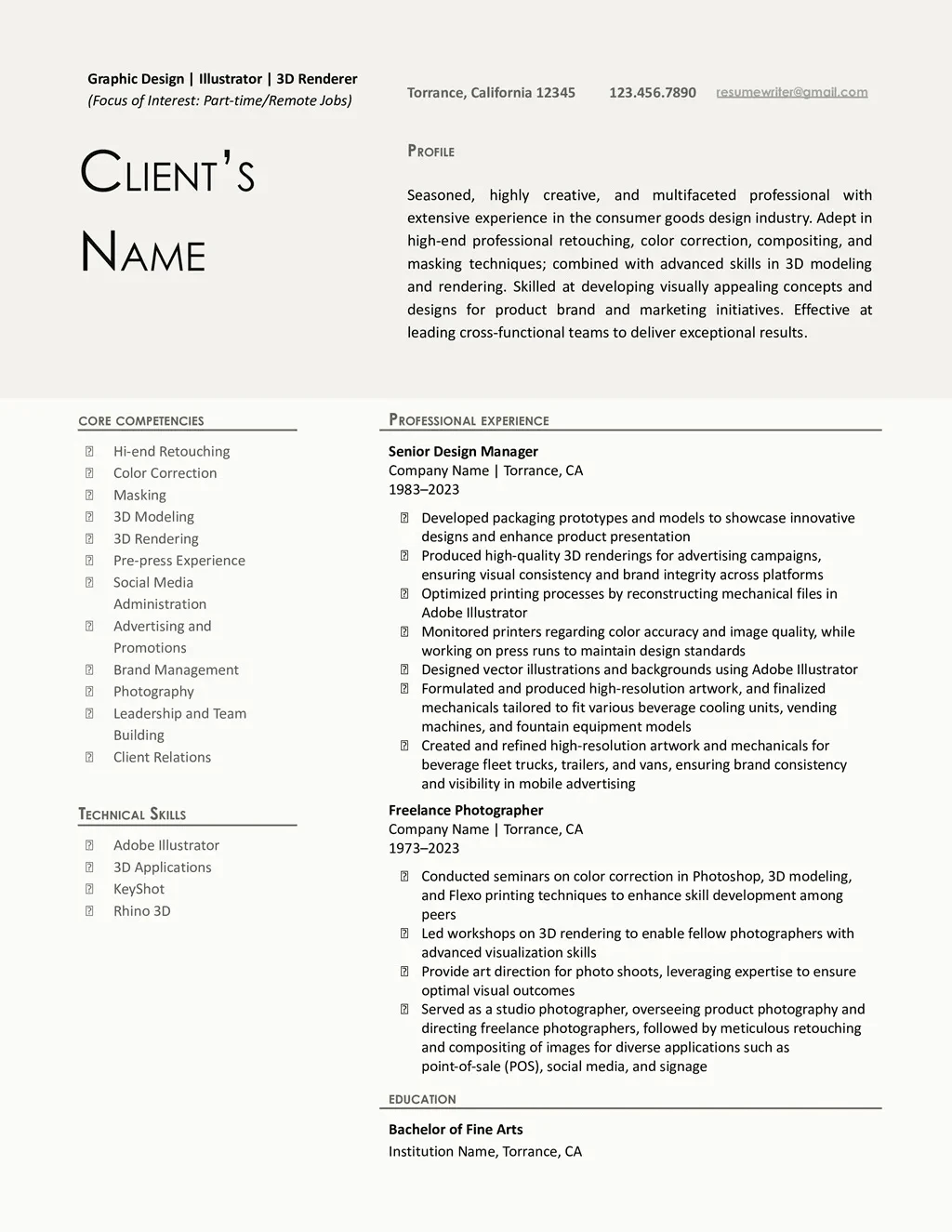For creative job seekers like graphic designers, a well-crafted resume is more than just a document where they can detail their experiences and list related skills — it’s a personal brand’s ambassador. And when it comes to graphic design, your resume isn’t just about conveying information; it’s also an opportunity to showcase your creativity, aesthetic sensibility, and attention to detail.
Crafting a compelling graphic design resume is a skill of striking a balance between style and substance, where each element serves to highlight your unique talents and qualifications. Who knows? Your dream design job could be just a well-crafted resume away.
In this comprehensive guide, read about the essential components of a standout resume and heed valuable tips to ensure yours catches the eye of potential employers and hiring managers. Whether you’re a seasoned professional looking to refresh your resume or a recent graduate entering the job market, this guide features insights and graphic designer resume examples to equip you with what you need to create a job search tool that stands out from the crowd.
What is a Graphic Designer?
Graphic design is a multifaceted discipline that revolves around the visual communication of ideas and information. It encompasses the art and skill of combining text, images, and other visual elements to convey messages effectively and aesthetically.
At its core, graphic design is about problem-solving. It involves understanding the needs and objectives of a project or client and using design principles to create solutions that resonate with the intended audience. From creating logos and branding materials to designing websites, posters, and advertisements, graphic designers play a crucial role in shaping the visual identity of businesses, organizations, and products.
In an increasingly visual world where first impressions matter, graphic design serves as a powerful tool for storytelling, persuasion, and brand differentiation. Effective graphic design not only captures attention but also communicates messages clearly and evokes desired emotions or actions from the audience.
Beyond mere aesthetics, graphic design requires a deep understanding of typography, color theory, layout, and composition. Hence, designers must not only possess technical proficiency in various software tools but also possess a keen eye for detail and a strong sense of creativity.

What are the Duties of a Graphic Designer?
As versatile visual communicators, graphic designers translate ideas into compelling visuals that captivate audiences across various mediums. Their duties encompass a wide range of tasks that require creativity, technical skill, and a keen eye for detail, such as the following:
- Conceptualizing and creating visually appealing designs for print, digital, and multimedia platforms
- Collaborating with clients or stakeholders to understand project requirements and objectives
- Developing brand identities, including logos, color schemes, and visual elements
- Designing marketing materials such as brochures, flyers, posters, and banners
- Crafting user interface (UI) and user experience (UX) designs for websites and mobile applications
- Selecting and incorporating appropriate typography, imagery, and layout elements to enhance visual impact
- Utilizing industry-standard software tools such as Adobe Creative Suite (Photoshop, Illustrator, InDesign) to execute design projects
- Conducting research on design trends, competitors, and target audiences to inform design decisions
- Providing feedback and revisions based on client or stakeholder input to ensure satisfaction and alignment with project goals
- Managing multiple projects simultaneously, adhering to deadlines, and maintaining high-quality standards throughout the design process
How Do You Become a Graphic Designer?
Becoming a graphic designer is a journey that combines creativity, technical skill, and a passion for visual communication. Whether you’re drawn to branding, web design, or print media, embarking on this career path requires dedication, perseverance, and a willingness to continually refine your craft.
Generally, this path may involve taking the following steps:
🔍 Think Your Resume’s Fine? Let’s Double-Check That
Even strong resumes can miss critical details—especially when it comes to passing Applicant Tracking Systems (ATS). Our specialists offer a free review to uncover gaps, improve formatting, and ensure your resume is ATS-ready and recruiter-friendly.
- Obtain a formal education in graphic design, either through a degree program or specialized courses, to develop foundational skills in design principles, typography, and software proficiency.
- Cultivate your creativity and artistic abilities by exploring various mediums, experimenting with different techniques, and seeking inspiration from art, design, and culture.
- Master industry-standard design software such as Adobe Creative Suite (Photoshop, Illustrator, InDesign) to effectively execute design projects and stay competitive in the field.
- Build a diverse portfolio showcasing your best work across different design disciplines, including branding, print, web, and multimedia, to demonstrate your skills and expertise to potential employers or clients.
- Gain practical experience through internships, freelance projects, or entry-level positions to apply your skills in real-world scenarios, build professional connections, and expand your portfolio.
- Stay updated on design trends, emerging technologies, and best practices by actively engaging with design communities, attending workshops or conferences, and continuously seeking opportunities for learning and growth.
- Cultivate strong communication and interpersonal skills to effectively collaborate with clients, colleagues, and stakeholders, and to articulate your design concepts and decisions with clarity and confidence.

What to Include in Your Graphic Designer Resume
Crafting a compelling graphic designer resume is essential to showcase your skills, experience, and unique design style to potential employers. Make sure to include these key elements in your graphic designer resume to make a lasting impression and increase your chances of landing your dream job:
Contact Information
Make sure that your resume includes your full name, professional title (e.g., lead graphic designer), email address, phone number, and optionally, your LinkedIn profile or a link to your personal website. Make sure your contact details are easily accessible and up to date to facilitate communication with potential employers.
Professional Summary or Objective
Craft a brief professional summary or objective statement that highlights your design expertise, relevant experience, and career goals. Use this section to provide a snapshot of your skills and accomplishments, emphasizing what you can offer to prospective employers.
Graphic Design Skills
List your technical skills, software proficiency, and design capabilities relevant to the graphic design role you’re applying for. Include both hard skills such as proficiency with Adobe Creative Suite and expertise in typography, as well as soft skills like creativity, attention to detail, and time management.
Experience
Detail your professional experience (usually in reverse chronological order, starting with your most recent position), especially those relevant to the role you’re vying for. Include the company name, your job title, and the dates of employment for each role. Describe your key responsibilities, accomplishments, and contributions to highlight your impact as a graphic designer.
Education
Provide information about your educational background, including the degree earned, institution attended, and graduation year. Don’t forget to mention any relevant coursework, honors, or extracurricular activities that demonstrate your commitment to graphic design and professional development.
Awards and Certifications
Highlight any awards or certifications you’ve received in recognition of your design work or professional achievements. Include details such as the name of the award or certification, the issuing organization, and the date received to showcase your credibility and expertise.
Career Portfolio
Include a link to your career portfolio or attach samples of your work to effectively present your design projects, creativity, and style. Curate your portfolio to feature a diverse range of projects that demonstrate your versatility and proficiency in various design mediums and styles. Ensure your portfolio is visually appealing and easy to navigate.

How to Write Your Graphic Designer Resume
Your graphic designer resume must be able to communicate your qualifications to potential employers, considering proper resume formatting and visual presentation.
To help you create a standout graphic designer resume that highlights your expertise and increases your chances of landing interviews, heed the following steps and tips:
Choose the right format.
Select a resume format that best highlights your skills and experience, whether it is chronological, functional, or combination format. Consider the industry norms and preferences when deciding on the layout and structure of your resume.
Create a visually appealing layout.
Design a clean and professional layout that enhances readability and visual appeal. Use appropriate fonts, spacing, and formatting to ensure your resume is easy to navigate and aesthetically pleasing.
Tailor your resume content.
Customize your resume to align with the specific requirements of the job you’re applying for. Tailor your content, including your professional summary, skills, experience, and portfolio, to highlight the most relevant qualifications for each position.
Proofread and edit as needed.
Pay attention to details such as formatting, punctuation, and alignment to maintain a polished and professional appearance. Alternatively, you can also consider seeking feedback from trusted peers or mentors to identify areas for improvement. Remember, a well-proofread and edited resume demonstrates your attention to detail and commitment to excellence, setting you apart as a professional graphic designer.
Graphic Designer Resume Example
Looking for inspiration on how to craft a graphic designer resume? Check out this practical example crafted by an expert resume writer:

Download a copy of the graphic designer resume example above.
Let Experts Take Care of Your Graphic Design Resume
Utilizing resume examples and guides as you prepare for your job search equips you with invaluable insights into structuring and presenting your professional information effectively. As a result, you can submit a resume that captures the attention of potential employers. However, leveraging the expertise of professionals through resume writing services is another effective way for you to ensure your job application tool lands you the job you want.
Don’t leave your career success to chance — let Resume Professional Writers’ resume writing services give your resume a boost and increase your chances of landing interviews. What are you waiting for? Contact us today to get started.You can also avail of our free resume review to get expert insights on your current draft!








